by Arthur Blade
Thousands of people stroll through Ibirapuera Park in São Paulo every day, thousands go to exercise, take their dogs, take their children, and often do not even notice the sculpture in the photo below. It is a bronze copy of the sculptural group Laocoonte that is in the Pio-Clementino Museum, in the Vatican, and that was made by the Lyceum of Arts and Crafts of São Paulo. The statue has been there since 1954, when the park opened.
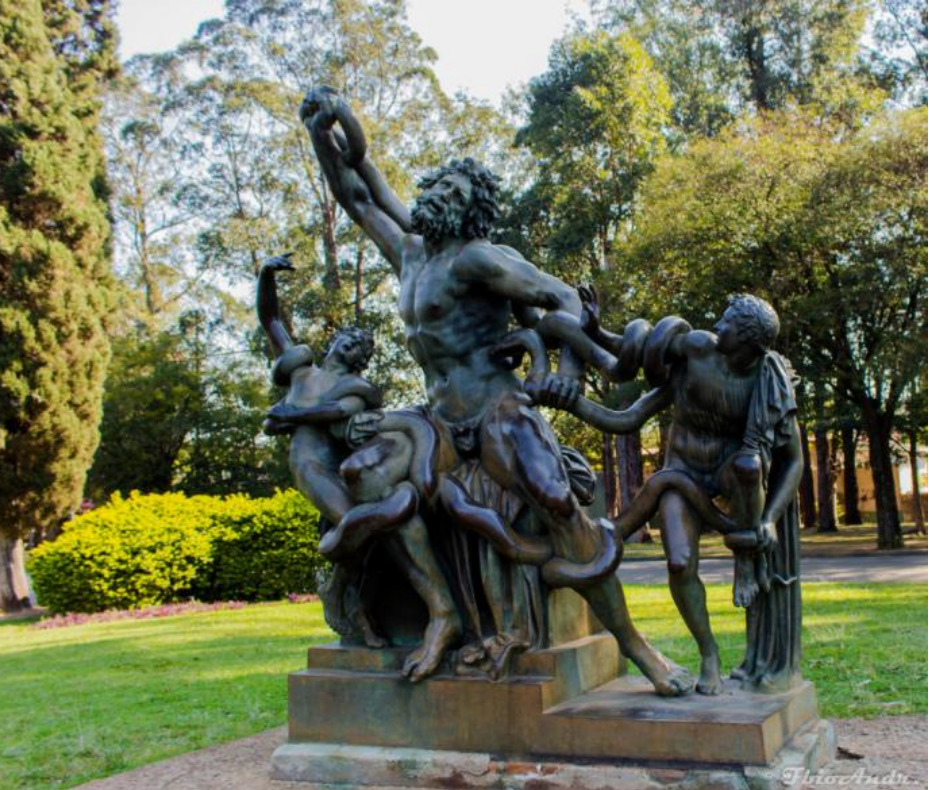
Well, people walk around Ibirapuera, many even take selfies with the Laocoon tearing themselves apart in pain, but the vast majority have no idea of the great epic adventure that is behind this sculpture.
At the beginning.
Caio Plínio Segundo (23 - 79), also known as Plínio the Elder, was a Roman naturalist. He is known to have written a great treatise in 37 volumes called: Natural History. In this work, he reveals a very high encyclopedic degree of knowledge dealing with the most varied sciences and arts until then under development. In one of his passages, in volume 36, he reports:
“… This is the case of the Laocoonte group, for example, in the palace of Emperor Tito, a work that can be considered preferable to any other production of the art of painting or [bronze] statuary. It is sculpted from a single block, both the main figure and the children, and the snakes with their wonderful folds. This group was made together by three of the most eminent artists, Agesandro, Polidoro and Atenodoro, native to Rhodes. ”
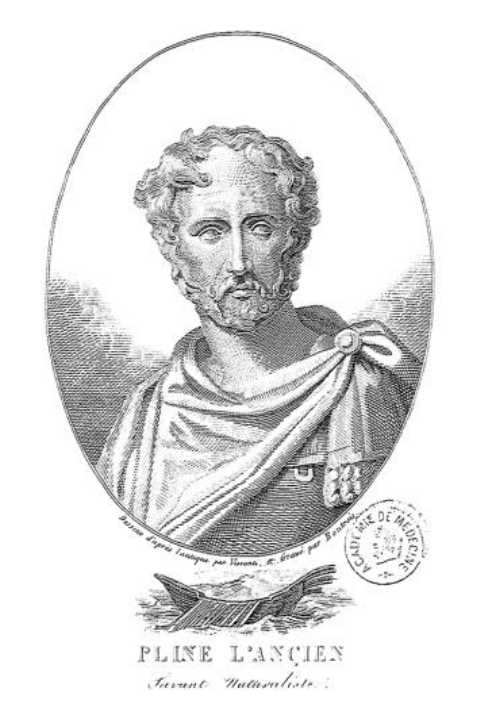
This reference was everything that scholars and artists of Michelangelo's time had about this statue. Plínio does not report the time when it was made or who ordered it. For about 1400 years the name Laocoonte, linked to the sculptural group, simply disappeared from history, until…
1506 - the year of the discovery of an icon
On January 14, 1506, the Roman Felice de Fredi, owner of a vineyard near the ancient Termas de Tito, when excavating his land for planting, finds a statue. At that time, the height of the Renaissance, classical sculpture was highly valued, Felice immediately sent for Giuliano de Sangallo, the architect of Pope Julius II and the main authority when it came to antiques and their authenticity.
It is at that moment that one of the great coincidences of history occurs, when Giuliano is warned, in the middle of lunch, guess who was in his company? Yes, Michelangelo was your guest for lunch that day. They then set off towards the discovery site. Alongside them was Giuliano's 11-year-old son, Francesco da Sangallo, who would become a sculptor and, sixty years later, would narrate the event:
“… So he left immediately. Since Michelangelo Buonarroti could always be found in our home, as he was hired for the tomb of Pope Julius II, my father wanted him to go too. I joined my father and off we went. I went down to where the statues were when my father immediately said:
"This is Laocoonte, which Plínio mentions."
On the ground that was then largely excavated, they found several parts of the sculptural ensemble, which can be seen in the photo below:
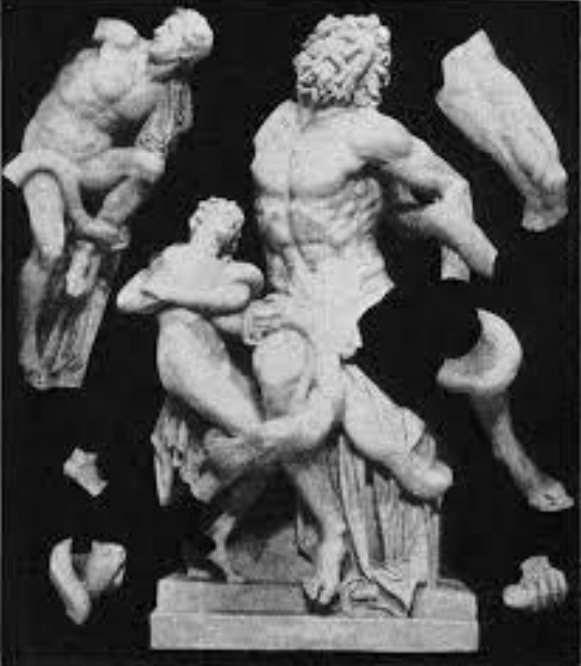
Pope Julius II, a passionate classicist.
The value of authentic antiquity was very high. Pope Julius II, a great admirer of classical culture, immediately bought it for the amount of 4,140 ducats, Felice de Fredi still received a lifetime pension of 600 ducats a year and, on dying, his discovery is mentioned on his tombstone.
An enigmatic statue like a sphinx.
As you can see, some parts were missing. Laocoonte's right arm was absent, in addition to the hand of one of the sons and the right arm of the other, as well as parts of the snakes.
At the time, the artists and other authorities debated how the missing parts would be to make a reconstitution. Michelangelo suggested that Laocoonte's right arm was turned backwards. The vast majority, including Rafael himself, believed that the arm would be stretched as a sign of great heroism. In 1510, Bramante, the Pope's architect, organized a vote among the main artists to decide whether the right arm is extended or tilted back. The first one wins and a copy is made thus restoring those that would be the missing parts. The engraving
below, by Marco Dente, from about 1515-27, reflects the whole without the additions.
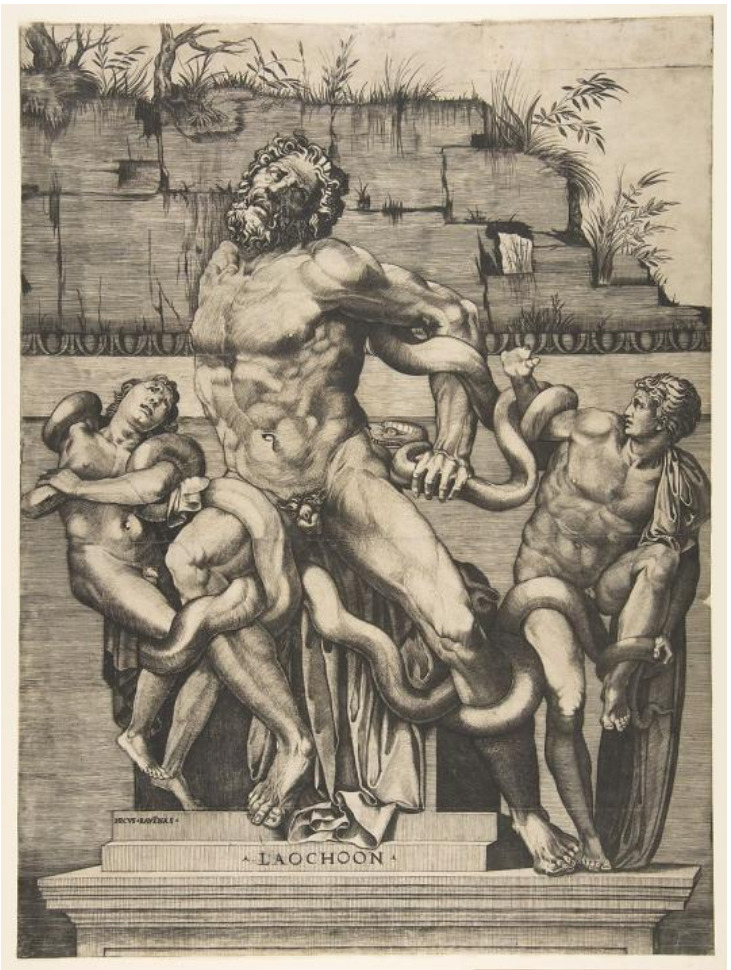
In this other engraving by Nicolas Béatrizet, from about 1535-65, there are the additions that were believed to exist in the original work, or that, at least, approached what would be the first work:
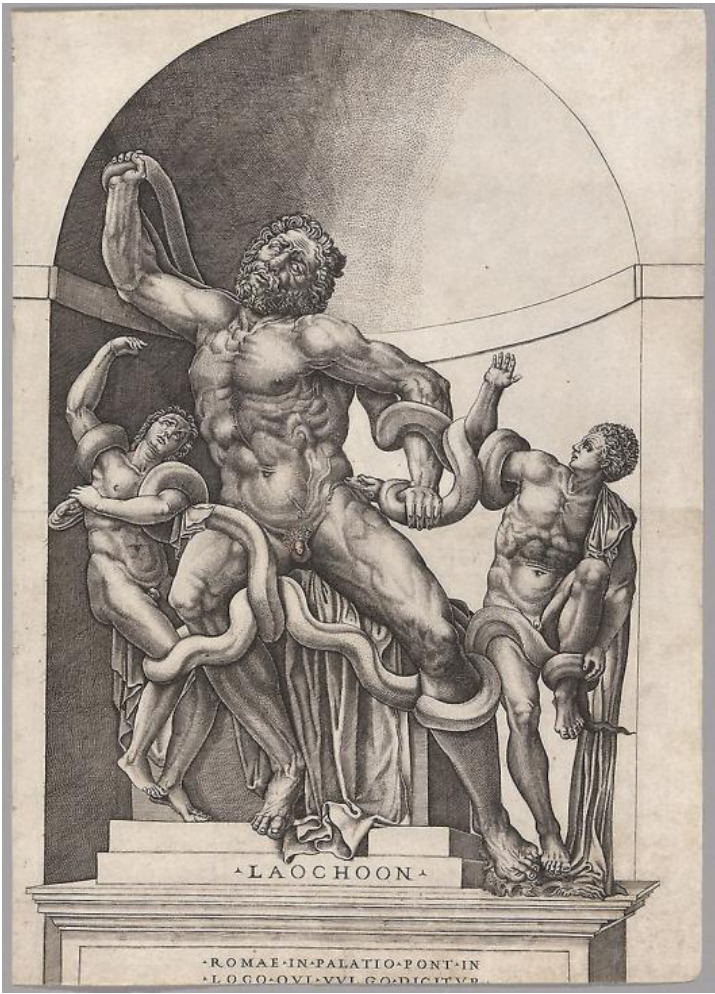
The impossible happens
In 1906 something happened that would be absolutely impossible. Something that anyone, with the slightest sense of probability, would say is more difficult than winning the lottery. Well, in 1906, the archaeologist and art dealer, Ludwig Pollack, entered Art History as the one who found Laocoonte's right-hand man. He found the arm fragment on the ground of a construction company near where the main parts of the work were found.
There are no details on how he found this part of the statue, the fact that adds to the improbabilities is that Pollack realized that it could be Laocoonte's arm, at a time when this matter was more than closed. That is, 400 years after the discovery of the main group, the arm is found. But he needed analysis, so he donated to the Vatican to get the study started again.
Four hundred years have passed. 1506 - 1906
In those 400 years, the sculpture had already undergone a true saga, had already undergone some restorations, because of the Napoleonic invasions it was taken to the Louvre as a loot, afterwards, with the loss of the Battle of Waterloo, it returned to Italy and, at the beginning of the 20th century, it was restored and with the missing parts added to the original work. So it was not enough to just put Pollack's arm next to the original sculpture, to see if it was Laocoonte's right arm.
And there go another 50 years
It was only in 1957 that the direction of the Vatican Museums decided to add the arm to the trunk of Laocoon. In the next photo you can see that they fit perfectly and that the conservation of the arm suffered the action of 400 years that separated it from the work to which it belonged.
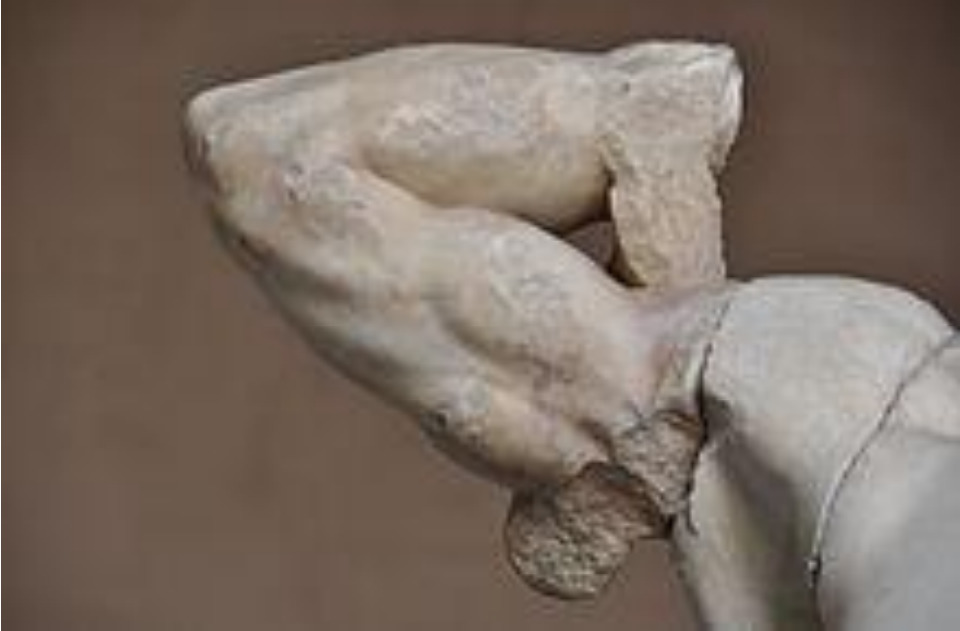
And that is why the replica of Ibirapuera Park has its arm extended, because it was made before 1957. And it was only in the 1980s that the added parts were completely removed and so the statue remained as it is now, only with the original parts:
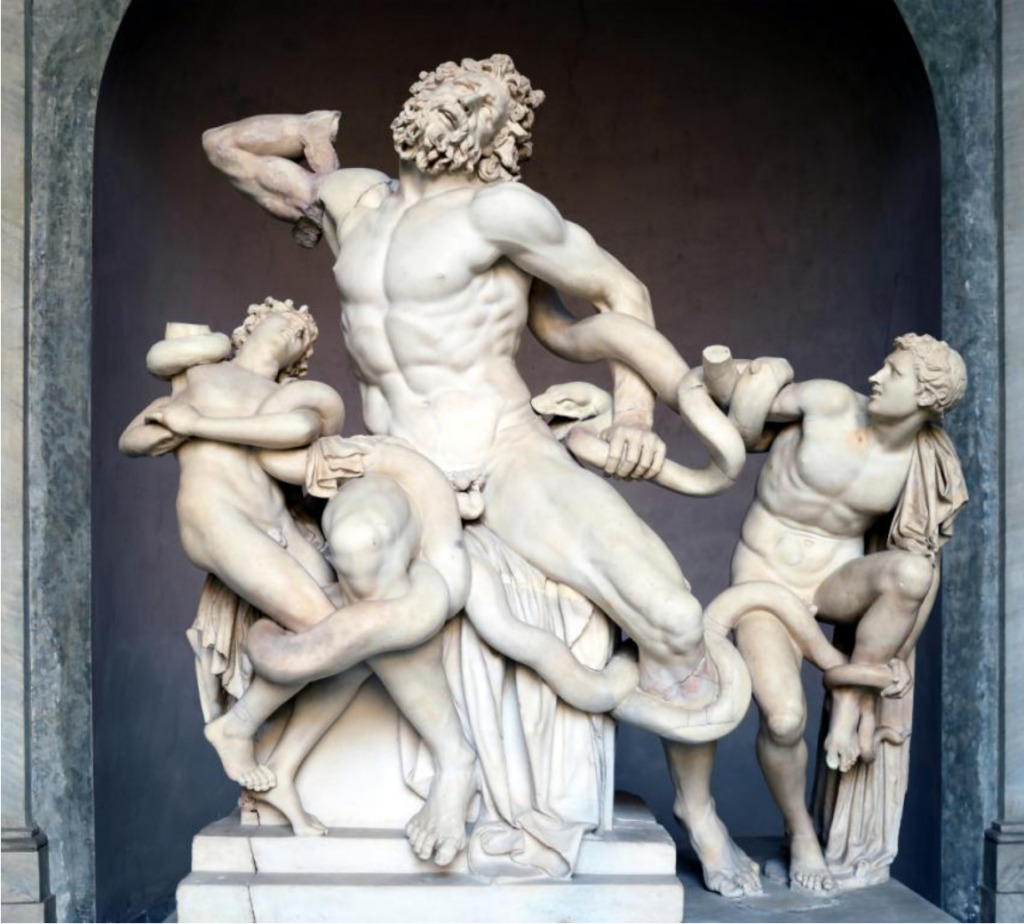
The great doubt
Between the lines of Michelangelo's biographies, there are those who maintain that it was he who sculpted the sculptural ensemble Laocoonte, and that, with his friend, Felice de Fredi, agreed to bury it, pass the work through antiquity, and thus obtain a large sum with the sale to Pope Julius II who would certainly buy it.
The coincidences are neither small nor small. Michelangelo was having lunch with Giuliano da Sangallo when news of the discovery of the sculpture appeared and he may be one of the first to arrive at the site. Then, when all the greatest artists of the time thought that the missing arm would be extended, Michelangelo gets up and says that he would be turned back, and 450 years later we realized that he was absolutely right.
The Sleeping Cupid
Another fact supports this hypothesis. There is a small statue of Sleeping Cupid, which today is lost, sculpted by Michelangelo in 1496, only that he aged it to pass through antiquity and sold it to an art dealer who, in turn, sold it to Cardinal Riario de San Giorgio. When the fraud was discovered, the Cardinal not only wanted to continue with the statue but also invited Michelangelo to go to Rome, where he would have his first orders for those that would be great masterpieces of humanity. He was 21 years old and this little forgery, this making a statue pass as antiquity using artifices like burying to look old, dealing with small scratches, producing small broken parts, may have made all the difference for him if project in the artistic universe of the time.
My own version
Laocoonte by Arthur Blade
Michelangelo, around 1506, was already considered “il divino” by sculptures like Bacchus, Pietá and David, his fame was already notorious, no
he would need money to maintain himself, much less, if he had
sculpted the Laocoonte group himself, he would stop showing his
talent telling everyone who was the author.
So what could have happened?
And this is where my own version of the story comes in.
Michelangelo knew the description of the sculptural group Laocoon
made by Plínio, I would certainly have kept that in mind and soon started to conceive what this statue would have been like. Michelangelo then, in secret, begins to sculpt what would be his first composition with three characters, a true virtuosity in a single marble block.
However, something inevitable happens, when the work is finished, when it is in the details of polishing the parts of the statue, a tiny crack in the marble and ... and part of the work accidentally breaks. This completely destroys him, he would never have a work that, even if well patched, would not satisfy him personally. He also knew that his enemies would use this detail to slander him. In addition, it would no longer be a statue made of a single marble block, as Plínio emphasized. It was all over.
He then works out an audacious plan with his friend Felice de Fredi, asks him to break the statue in parts (Michelangelo would never be able to break a masterpiece of humanity himself), then disappear with some small parts, make some scratches, age best possible way and bury in Felice's vineyard. The continuation of the story we already know.
The truth is yet to be unearthed.
The critics' position is still controversial, some still believe that Laocoon is the original Greek statue with uncertain dates; others say it is a copy of a Greek bronze statue from the 11th century BC that did not reach us; there are also those who say that it is not a single marble block, in short, the truth will remain buried forever.
Michelangelo, the greatest counterfeiting genius in art history
My version is absolutely plausible, marble is a material that breaks easily, Michelangelo, with his strong temperament, may well have followed the steps I mentioned.
And if that really happened, Michelangelo presented us with masterpieces such as Pietá, David, the ceiling of the Sistine Chapel, the Fresco of the Last Judgment, the Moses and… that which is the maximum masterpiece of the Greek statuary, the sculptural ensemble of Laocoon. And on top of all his genius, Michelangelo smiles for having convinced everyone that Laocoon is a Greek statue, he even matched the Greeks.
Michelangelo, the greatest counterfeiting genius in art history.
Per
Arthur Blade

Responses